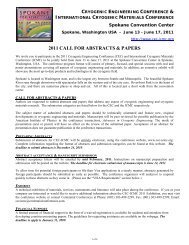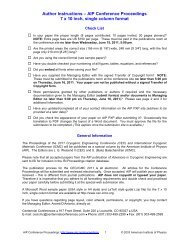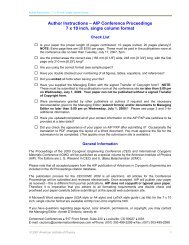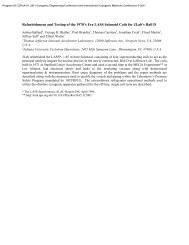CEC Abstracts in PDF format (as of 7/3/07) - CEC-ICMC 2013
CEC Abstracts in PDF format (as of 7/3/07) - CEC-ICMC 2013
CEC Abstracts in PDF format (as of 7/3/07) - CEC-ICMC 2013
You also want an ePaper? Increase the reach of your titles
YUMPU automatically turns print PDFs into web optimized ePapers that Google loves.
<strong>CEC</strong> 20<strong>07</strong> - <strong>Abstracts</strong><br />
C3-K Thermal Insulation Systems - II<br />
C3-K-01 Vacuum-Insulated, Flexible Cryostats for Long<br />
HTS Cables: Requirements, Status and Prospects<br />
M.J. Gouge, J.A. Demko, ORNL; J.F. Maguire,<br />
AMSC; M.L. Roden, Southwire Company; C.S. Weber,<br />
SuperPower, Inc..<br />
Several high temperature superconduct<strong>in</strong>g (HTS) cable demonstration<br />
projects have begun operation on the electric grid <strong>in</strong> the l<strong>as</strong>t year with<br />
the liquid nitrogen-cooled cable conta<strong>in</strong>ed <strong>in</strong> one or more vacuum<strong>in</strong>sulated,<br />
flexible cryostats with lengths up to 600 meters. These grid<br />
demonstration projects are prototypes <strong>of</strong> the anticipated commercial<br />
market which will require superconduct<strong>in</strong>g cable lengths <strong>in</strong> the<br />
multiple kilometer range with the vacuum-jacketed cryostats <strong>in</strong><br />
underground ducts provid<strong>in</strong>g acceptable thermal <strong>in</strong>sulation for<br />
decades. The current state-<strong>of</strong>-the art for flexible cryostats (<strong>in</strong>stallation<br />
constra<strong>in</strong>ts, heat loads with a good and degraded vacuum, impact <strong>of</strong><br />
cable bends, getter lifetime and reliability) is discussed. Further<br />
development needed to meet the challeng<strong>in</strong>g commercial HTS cable<br />
application is outl<strong>in</strong>ed.<br />
Research sponsored by the U.S. Department <strong>of</strong> Energy - Office <strong>of</strong><br />
Electricity Delivery and Energy Reliability, Superconductivity<br />
Program for Electric Power Systems under contract DE-AC05-<br />
00OR22725 with Oak Ridge National Laboratory, managed and<br />
operated by UT-Battelle, LLC.<br />
C3-K-02 Heat Flow Me<strong>as</strong>urement and Analysis <strong>of</strong><br />
Thermal Vacuum Insulation<br />
C. Laa, C. Hirschl, J. Stipsitz, Austrian Aerospace<br />
GmbH.<br />
A new k<strong>in</strong>d <strong>of</strong> calorimeter h<strong>as</strong> been developed to obta<strong>in</strong> specific<br />
material parameters needed for the analysis <strong>of</strong> thermal vacuum<br />
<strong>in</strong>sulation. A detailed description <strong>of</strong> the me<strong>as</strong>ur<strong>in</strong>g device and the<br />
me<strong>as</strong>urement results will be given <strong>in</strong> this paper.<br />
This calorimeter facility allows to me<strong>as</strong>ure the heat flow through the<br />
<strong>in</strong>sulation under vacuum conditions <strong>in</strong> a wide temperature range from<br />
liquid nitrogen to ambient. Both boundary temperatures can be chosen<br />
with<strong>in</strong> this range. The <strong>in</strong>sulation can be characterized at high vacuum<br />
or under degraded vacuum, the latter us<strong>in</strong>g helium or nitrogen g<strong>as</strong>.<br />
The mechanisms <strong>of</strong> heat transfer have been <strong>in</strong>vestigated, namely<br />
<strong>in</strong>frared radiation between the reflective layers <strong>of</strong> the <strong>in</strong>sulation and<br />
conduction through the <strong>in</strong>terleav<strong>in</strong>g spacer material. A mathematical<br />
description <strong>of</strong> the heat flow through the <strong>in</strong>sulation h<strong>as</strong> been derived.<br />
B<strong>as</strong>ed on this the heat flow for a typical <strong>in</strong>sulation material h<strong>as</strong> been<br />
calculated by f<strong>in</strong>ite element analysis by use <strong>of</strong> the s<strong>of</strong>tware tool<br />
ANSYS. Such a transient calculation is needed to determ<strong>in</strong>e the time<br />
to reach thermal equilibrium, which is mandatory for a proper<br />
<strong>in</strong>terpretation and evaluation <strong>of</strong> the me<strong>as</strong>urement.<br />
The new <strong>in</strong>sulation me<strong>as</strong>urement results comb<strong>in</strong>ed with the proposed<br />
type <strong>of</strong> analysis can be applied to better understand the thermal<br />
behavior <strong>of</strong> any k<strong>in</strong>d <strong>of</strong> cryogenic system.<br />
C3-K-03 Robust Multilayer Insulation for Cryogenic<br />
Systems<br />
J.E. Fesmire, B.E. Scholtens, NASA KSC; S.D.<br />
Augustynowicz, Sierra Lobo, Inc..<br />
New requirements for thermal <strong>in</strong>sulation <strong>in</strong>clude robust multilayer<br />
<strong>in</strong>sulation (MLI) systems that work for a range <strong>of</strong> environments from<br />
high vacuum to no vacuum. Improved MLI systems must be simple<br />
to <strong>in</strong>stall and ma<strong>in</strong>ta<strong>in</strong> while meet<strong>in</strong>g the life-cycle cost and thermal<br />
performance objectives. Performance <strong>of</strong> MLI systems <strong>in</strong> actual use<br />
h<strong>as</strong> been shown to be much worse than the ideal c<strong>as</strong>e. Industry<br />
products us<strong>in</strong>g robust MLI can benefit from improved cost-efficiency<br />
and system safety. Spacecraft that must store cryogens dur<strong>in</strong>g all<br />
mission ph<strong>as</strong>es, <strong>in</strong>clud<strong>in</strong>g orbital/lunar service (high vacuum) and<br />
ground launch operations (no vacuum) are planned. Future cryogenic<br />
spacecraft for the s<strong>of</strong>t vacuum environment <strong>of</strong> Mars are also<br />
envisioned. Novel materials have been developed to operate <strong>as</strong><br />
excellent thermal <strong>in</strong>sulators at vacuum levels that are much less<br />
str<strong>in</strong>gent than the absolute high vacuum requirement <strong>of</strong> current MLI<br />
systems.<br />
One such robust system, Layered Composite Insulation (LCI), h<strong>as</strong><br />
been developed at the Cryogenics Test Laboratory <strong>of</strong> NASA Kennedy<br />
Space Center. The experimental test<strong>in</strong>g and development <strong>of</strong> LCI is<br />
the focus <strong>of</strong> this paper. Compared to MLI under cryogenic<br />
conditions, LCI thermal performance is shown to be six times better at<br />
s<strong>of</strong>t vacuum and similar at high vacuum. The apparent thermal<br />
conductivity (k-value) and heat flux data for LCI systems are<br />
compared with other MLI systems.<br />
C3-K-04 Synthesis on the multilayer cryogenic vacuum<br />
<strong>in</strong>sulation modell<strong>in</strong>g and me<strong>as</strong>urements<br />
M. Chorowski, J. Pol<strong>in</strong>ski, Wroclaw University <strong>of</strong><br />
Technology.<br />
A thermodynamic approach towards <strong>in</strong>sulation systems <strong>in</strong> cryogenic<br />
eng<strong>in</strong>eer<strong>in</strong>g is proposed. A mathematical model <strong>of</strong> the heat transfer<br />
through multilayer <strong>in</strong>sulation (MLI) h<strong>as</strong> been developed and<br />
experimentally verified. The model comprises both physical and<br />
eng<strong>in</strong>eer<strong>in</strong>g parameters determ<strong>in</strong><strong>in</strong>g the MLI performance and enables<br />
a complex optimisation <strong>of</strong> the <strong>in</strong>sulation system <strong>in</strong>clud<strong>in</strong>g the choice<br />
<strong>of</strong> the <strong>in</strong>sulation location <strong>in</strong> a vacuum space. The model takes <strong>in</strong>to<br />
account an <strong>in</strong>terstitial (<strong>in</strong>terlayer) g<strong>as</strong> pressure and a shield – spacer<br />
thermal contact resistance variation with the MLI layer density. The<br />
paper presents the discussion <strong>of</strong> MLI performance <strong>in</strong> different<br />
conditions and provides comparison <strong>of</strong> computation results with<br />
experimental reference data. The optimisation <strong>of</strong> the <strong>in</strong>sulation for<br />
different boundary conditions is analysed and concluded.<br />
C3-K-05 Thermal Performance Comparison <strong>of</strong> Gl<strong>as</strong>s<br />
Microsphere and Perlite Insulation Systems for Liquid<br />
Hydrogen Storage Tanks<br />
J.P. S<strong>as</strong>s, J.E. Fesmire, D.L. Morris, NASA KSC; Z.F.<br />
Nagy, S.D. Augustynowicz, Sierra Lobo, Inc.; S.J.<br />
Sojourner, ASRC Aerospace.<br />
A technology demonstration test project w<strong>as</strong> conducted by the<br />
Cryogenics Test Laboratory at the Kennedy Space Center (KSC) to<br />
provide comparative thermal performance data for gl<strong>as</strong>s microsphere<br />
and perlite <strong>in</strong>sulation for liquid hydrogen tank applications. Two<br />
identical 1/15th scale versions <strong>of</strong> the 850,000 gallon spherical liquid<br />
hydrogen tanks at Launch Complex 39 at KSC were custom designed<br />
and built to serve <strong>as</strong> test articles for this test project. Evaporative<br />
(boil-<strong>of</strong>f) calorimeter test protocols, <strong>in</strong>clud<strong>in</strong>g liquid hydrogen and<br />
liquid nitrogen, were established to provide tank test conditions<br />
characteristic <strong>of</strong> the large storage tanks that support the Space Shuttle<br />
launch operations. This paper provides comparative thermal<br />
performance test results for gl<strong>as</strong>s microspheres and perlite for a wide<br />
range <strong>of</strong> conditions. Limited results for aerogel <strong>in</strong>sulation material<br />
are also <strong>in</strong>cluded. Aerogel-b<strong>as</strong>ed <strong>in</strong>sulation systems are targeted for<br />
non-evacuated liquid oxygen tank applications due to cost and<br />
performance parameters. Thermal performance <strong>as</strong> a function <strong>of</strong><br />
cryogenic commodity (hydrogen and nitrogen), vacuum pressure,<br />
<strong>in</strong>sulation fill level, tank liquid level, and thermal cycles will be<br />
presented.<br />
Fund<strong>in</strong>g w<strong>as</strong> provided by the NASA Space Operations Mission<br />
Directorate under the Internal Research and Development project<br />
New Materials and Technologies for Cost-Efficient Storage and<br />
Transfer <strong>of</strong> Cryogens.<br />
Page 43 <strong>of</strong> 53






